"It's time to do business" finally flew
On November 11, from the third series of attempts, the first commercial mission of the launch vehicle Electron “It's Business Time” finally went to flight. The launch was successful, and now, as if arguing with eight-month postponements, Rocket Lab is going to test its capabilities to launch rockets quickly - the next fourth start of Electron is already scheduled for December.
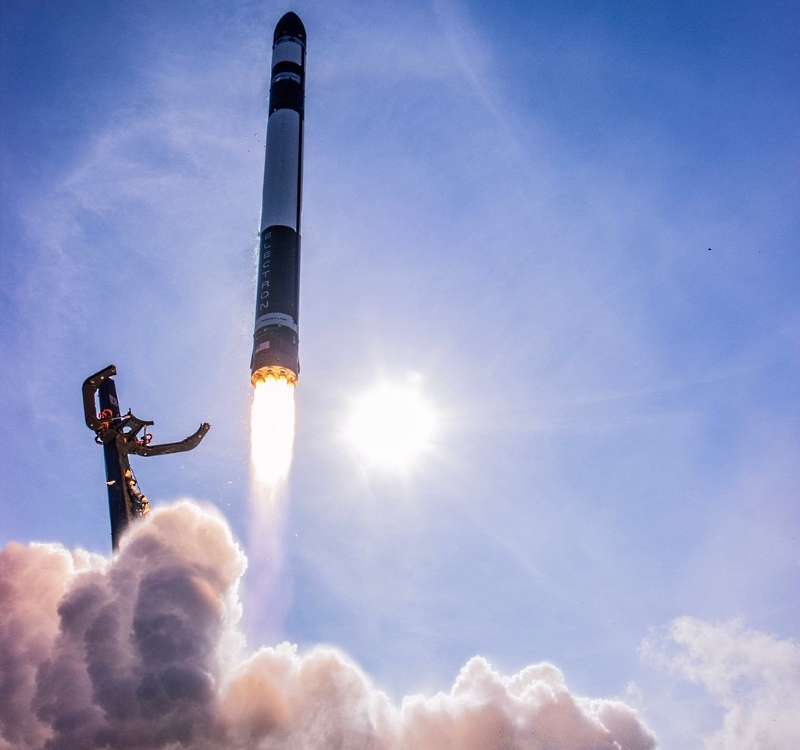
Photo Rocket Lab
Nine days were allocated to the starting window - from 11 to 19 November. But contrary to already established traditions, when the weather or minor technical problems constantly prevent the launch, this time the rocket went flying on the first day (from 19:46).
It seems that in 2018 there were changes in the rocket design. In earlier versions of the flight sequence diagram, the first stage was dropped to 2:42, and now to 2:33. Fuel ends earlier, so it is logical to assume that Rocket Lab has managed to increase engine thrust. There is another option that less fuel was poured into the first stage, but this is less likely. Other marks of the cyclogram also underwent changes - the head fairing is now reset a couple of seconds later - 3:08 instead of 3:06. This may indicate a slight change in the trajectory to a more gentle one - the fairing weighs a lot, and without the need for no one to carry it on the rocket for a single second will not.
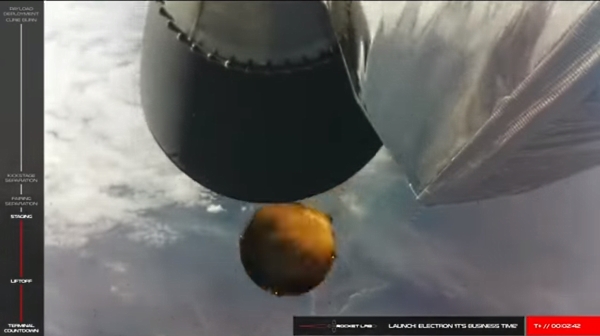
Separation of the first stage, a frame from the broadcast
At 7:10, an operation is being carried out, which so far is being done only on Electron - the discharge of two blocks of lithium-ion batteries. Let me remind you that for the sake of simplicity and cheapening of engines, the fuel in them is supplied not by turbopump units but by electric pumps. At the second stage there are three battery packs for powering the pumps, and two of them are dropped in flight.
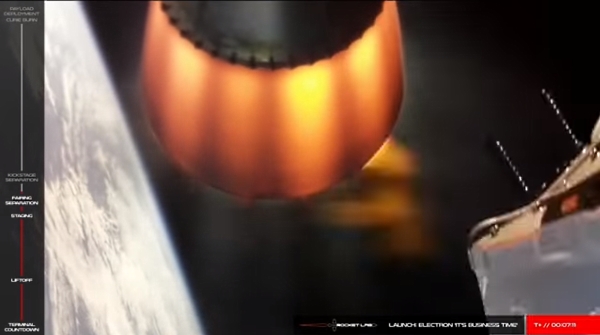
Battery reset, broadcast frame
Indirectly, an increase in the second stage says about the increase in thrust - 9:09 in the new version instead of 9:20. At this moment, the third stage was in orbit 210x500 km. The third stage flies with the engine off to the apogee of 500 km and turns on its Curie engine there. The switch-on time in the old and new versions of the sequence diagram differs by one second, which indicates the same orbit parameters. It is interesting that in the new version the third stage worked for 38 seconds more, turning off at 52:45 instead of 52:07.
At the same time, the payload mass increased with time — the number of satellites increased from three to five by summer, and as a result, seven flew. But their total mass is around 40 kg, which is noticeably less than the planned value of 150 kg and a maximum carrying capacity of 225 kg.
The first startup window for It's Business Time was supposed to open on April 20th. But this was not to happen - due to the “unusual” behavior of the motor controller, on April 17 the start was postponed to “several weeks”. Initially, three satellites should have become a payload - two LEMUR-2 from Spire Global and the CICERO, Tyvak Nano-Satellite Systems for GeoOptics Inc. devices.
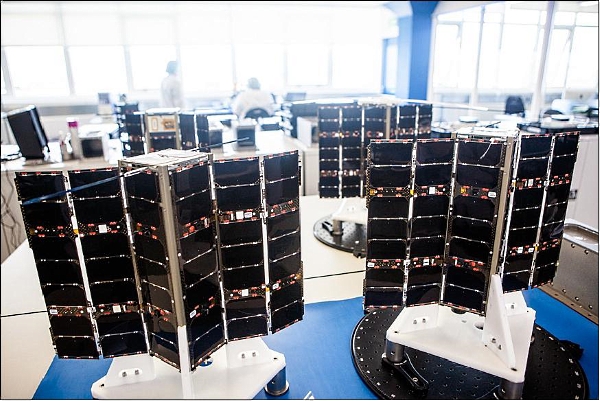
LEMUR-2, photo Spire Global
"Lemurs" are used mainly to track the ships and launch an associated load on different missiles, they have already produced more than eighty. But they also measure the passage of a GPS navigation signal through the atmosphere, recording its temperature, pressure and humidity.
CICERO uses the same principle as Lemurs, besides it measures the GPS and Galileo signal reflected from the surface, studying the characteristics of the ocean and ice.
We decided to open the second starting window from June 23 to July 6. On the first day there was a problem with the antenna of the ground tracking station, which could not be fixed until the end of the time window. Then three days were gone due to the weather. And on June 27, the problem with the motor controller was again manifested. As a result, the start was postponed to November.
On the second attempt on the rocket there were already five satellites - IRVINE01 and NABEO were added.
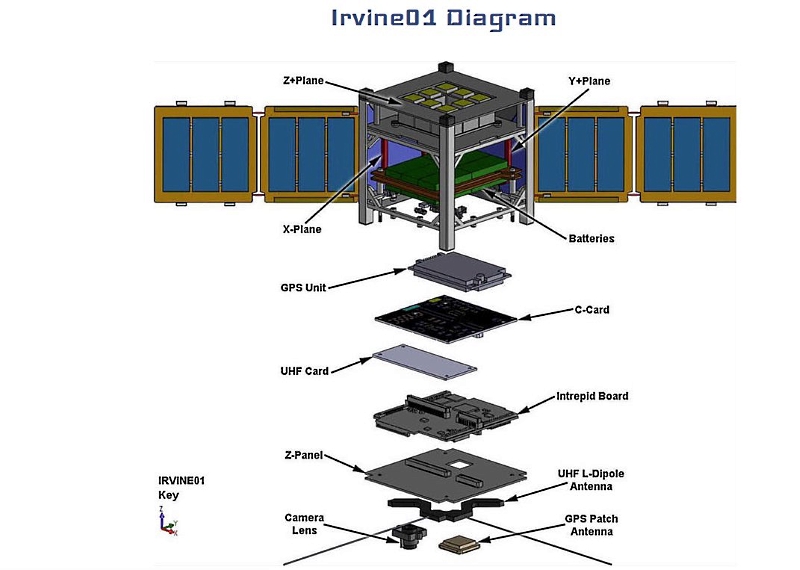
IRVINE01, IrvineCubesat.org scheme
Student IRVINE01 carries a low-resolution camera for photographing Venus and other celestial objects. The data from the camera will be used to determine the distance to the stars and the accuracy of the orientation system of the satellite itself.
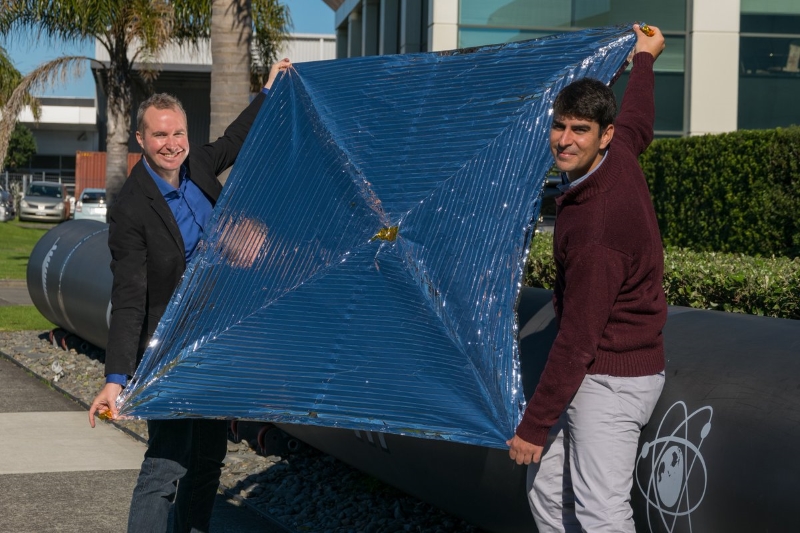
NABEO, photo HPS GmbH
NABEO is a technological demonstrator of the passive orbital satellites. Initially it was assumed that he would remain attached to the third stage, unfold the cloth in the photo above and slow it down. But now the program has been changed - the satellite has separated from the third stage and will go out of its orbit independently. And the third step performed a braking maneuver on its engine.
And finally, by the fall, two more Proxima satellites from Fleet Space Technologies appeared on the rocket. The group of Proxima satellites being created will work on the Internet of Things, providing satellite Internet access for various sensors on Earth.
It is worth noting that the cosmodrome is located in a place that is not very good in terms of weather, and the new technology still presents surprises. So the launch on the first day of the launch window was a pleasant surprise.
The launch was successful, and customers are happy with the signals of their long-awaited devices. The loudest of all, probably, heard the creators of IRVINE01, students, after all.
Meanwhile, Rocket Lab has confirmed the ambitious plans announced earlier to launch one Electron each month. According to the head of the company, Peter Beck, the pace of production of rockets is already approaching those required, it remains to learn how to launch them. The company's website talks about the successful scaling of the work on the production of missiles and preparing them for launch, when different operations begin to be performed at different sites, and by the end of 2020 Rocket Lab is going to launch one rocket per week. Returning to the present, the next launch is scheduled for December, when the NASA ELaNa 19 mission with 10 cubic meters is to go on a mission.

Photo Rocket Lab
Chronicle and cyclogram
Nine days were allocated to the starting window - from 11 to 19 November. But contrary to already established traditions, when the weather or minor technical problems constantly prevent the launch, this time the rocket went flying on the first day (from 19:46).
It seems that in 2018 there were changes in the rocket design. In earlier versions of the flight sequence diagram, the first stage was dropped to 2:42, and now to 2:33. Fuel ends earlier, so it is logical to assume that Rocket Lab has managed to increase engine thrust. There is another option that less fuel was poured into the first stage, but this is less likely. Other marks of the cyclogram also underwent changes - the head fairing is now reset a couple of seconds later - 3:08 instead of 3:06. This may indicate a slight change in the trajectory to a more gentle one - the fairing weighs a lot, and without the need for no one to carry it on the rocket for a single second will not.

Separation of the first stage, a frame from the broadcast
At 7:10, an operation is being carried out, which so far is being done only on Electron - the discharge of two blocks of lithium-ion batteries. Let me remind you that for the sake of simplicity and cheapening of engines, the fuel in them is supplied not by turbopump units but by electric pumps. At the second stage there are three battery packs for powering the pumps, and two of them are dropped in flight.

Battery reset, broadcast frame
Indirectly, an increase in the second stage says about the increase in thrust - 9:09 in the new version instead of 9:20. At this moment, the third stage was in orbit 210x500 km. The third stage flies with the engine off to the apogee of 500 km and turns on its Curie engine there. The switch-on time in the old and new versions of the sequence diagram differs by one second, which indicates the same orbit parameters. It is interesting that in the new version the third stage worked for 38 seconds more, turning off at 52:45 instead of 52:07.
At the same time, the payload mass increased with time — the number of satellites increased from three to five by summer, and as a result, seven flew. But their total mass is around 40 kg, which is noticeably less than the planned value of 150 kg and a maximum carrying capacity of 225 kg.
Ship is loading here
The first startup window for It's Business Time was supposed to open on April 20th. But this was not to happen - due to the “unusual” behavior of the motor controller, on April 17 the start was postponed to “several weeks”. Initially, three satellites should have become a payload - two LEMUR-2 from Spire Global and the CICERO, Tyvak Nano-Satellite Systems for GeoOptics Inc. devices.

LEMUR-2, photo Spire Global
"Lemurs" are used mainly to track the ships and launch an associated load on different missiles, they have already produced more than eighty. But they also measure the passage of a GPS navigation signal through the atmosphere, recording its temperature, pressure and humidity.
CICERO uses the same principle as Lemurs, besides it measures the GPS and Galileo signal reflected from the surface, studying the characteristics of the ocean and ice.
We decided to open the second starting window from June 23 to July 6. On the first day there was a problem with the antenna of the ground tracking station, which could not be fixed until the end of the time window. Then three days were gone due to the weather. And on June 27, the problem with the motor controller was again manifested. As a result, the start was postponed to November.
On the second attempt on the rocket there were already five satellites - IRVINE01 and NABEO were added.

IRVINE01, IrvineCubesat.org scheme
Student IRVINE01 carries a low-resolution camera for photographing Venus and other celestial objects. The data from the camera will be used to determine the distance to the stars and the accuracy of the orientation system of the satellite itself.

NABEO, photo HPS GmbH
NABEO is a technological demonstrator of the passive orbital satellites. Initially it was assumed that he would remain attached to the third stage, unfold the cloth in the photo above and slow it down. But now the program has been changed - the satellite has separated from the third stage and will go out of its orbit independently. And the third step performed a braking maneuver on its engine.
And finally, by the fall, two more Proxima satellites from Fleet Space Technologies appeared on the rocket. The group of Proxima satellites being created will work on the Internet of Things, providing satellite Internet access for various sensors on Earth.
It is worth noting that the cosmodrome is located in a place that is not very good in terms of weather, and the new technology still presents surprises. So the launch on the first day of the launch window was a pleasant surprise.
Big plans
The launch was successful, and customers are happy with the signals of their long-awaited devices. The loudest of all, probably, heard the creators of IRVINE01, students, after all.
Meanwhile, Rocket Lab has confirmed the ambitious plans announced earlier to launch one Electron each month. According to the head of the company, Peter Beck, the pace of production of rockets is already approaching those required, it remains to learn how to launch them. The company's website talks about the successful scaling of the work on the production of missiles and preparing them for launch, when different operations begin to be performed at different sites, and by the end of 2020 Rocket Lab is going to launch one rocket per week. Returning to the present, the next launch is scheduled for December, when the NASA ELaNa 19 mission with 10 cubic meters is to go on a mission.
